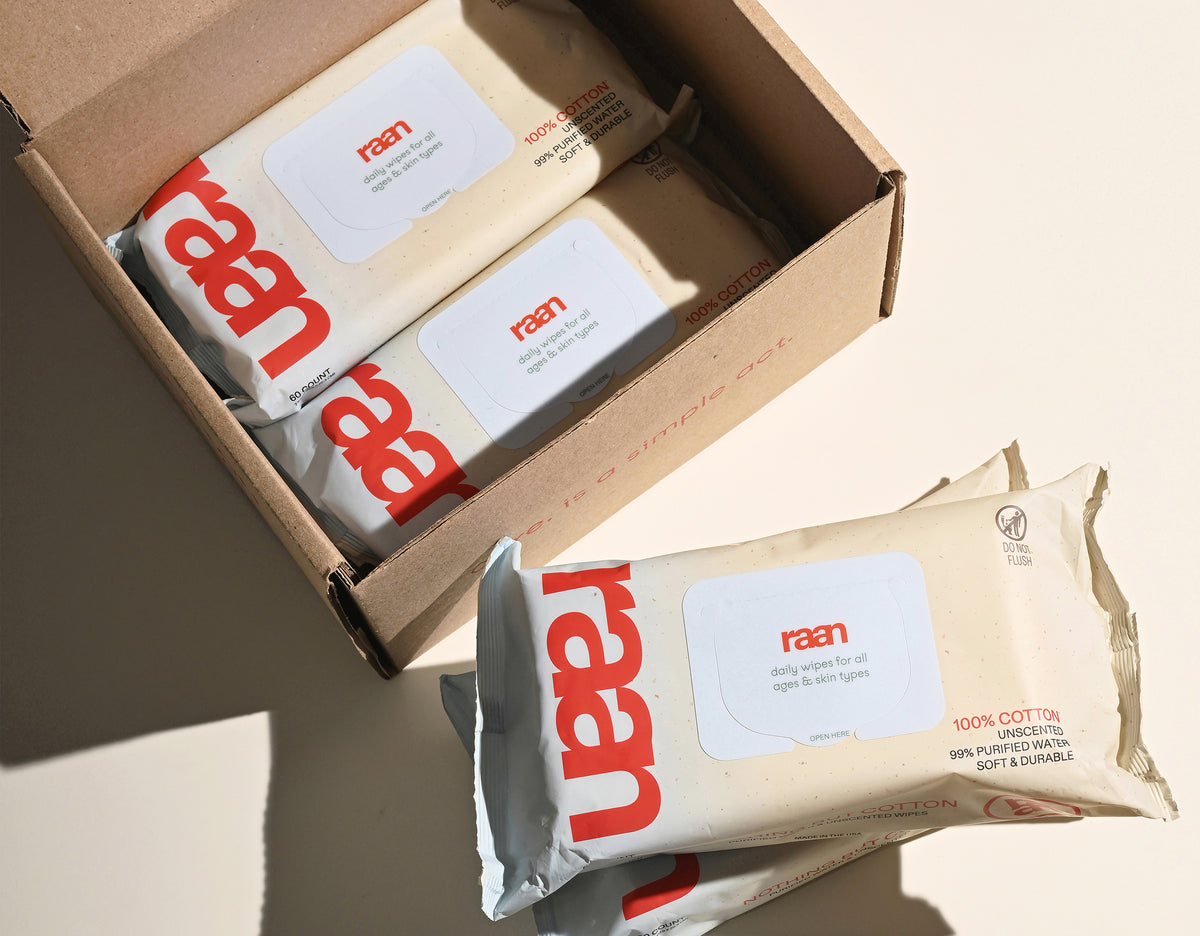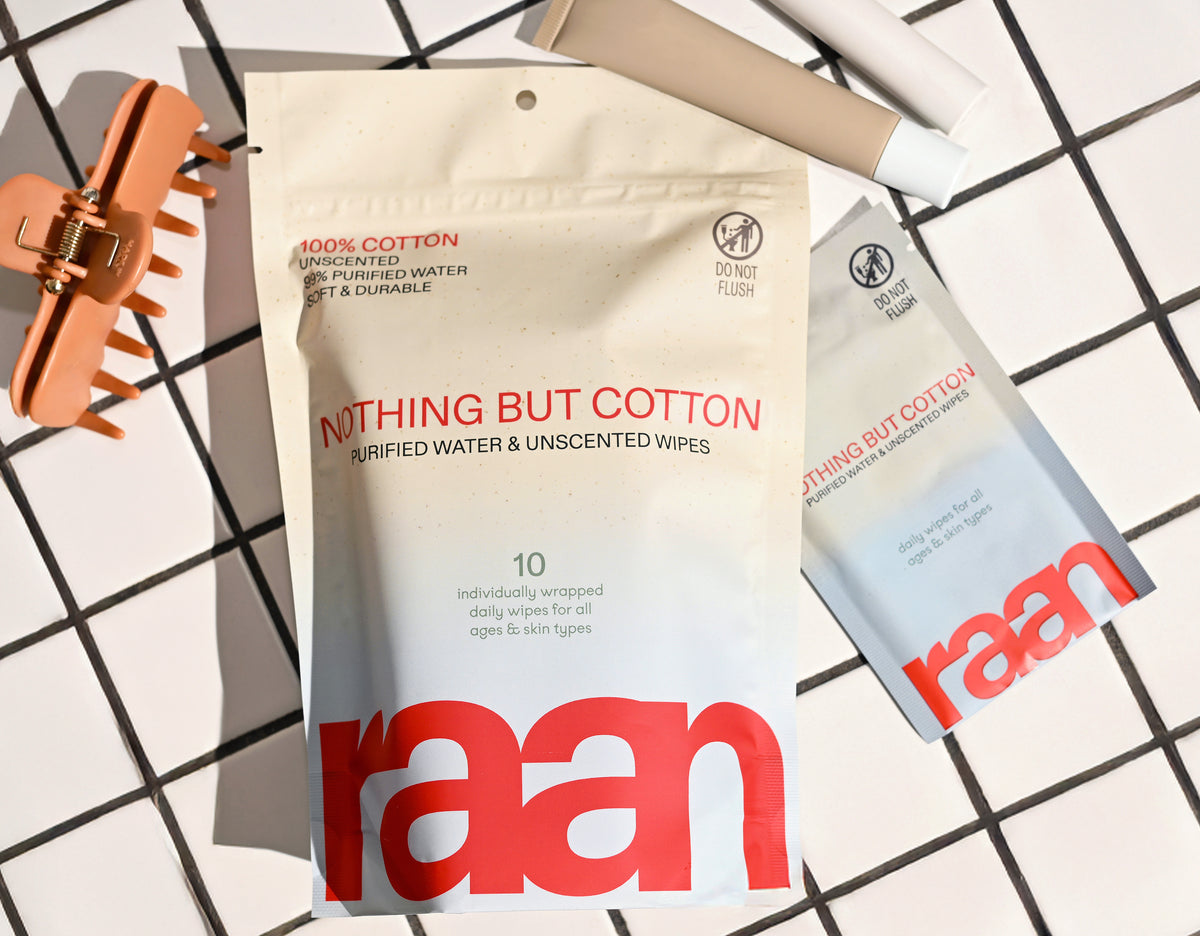Key Takeaways
- Parents often feel overwhelmed by the numerous baby wipe options and their marketing claims.
- Many baby wipes contain ingredients that are difficult to understand or identify.
- It is important to know what ingredients are in wipes that come into contact with your baby's skin.
- Choosing hypoallergenic cotton wipes can provide peace of mind for parents concerned about skin sensitivity.
Table of Contents
- Why Hypoallergenic Cotton Wipes Matter for Your Baby (and Your Peace of Mind)
- What Are Hypoallergenic Cotton Wipes, Really?
- Why Your Baby's Skin Needs Special Attention
- The Danger List: What to Avoid in Baby Wipes
- Inside the Pack: Raan's Hypoallergenic Cotton Wipes Formula
- The Real Difference: Hypoallergenic Cotton vs. Regular Baby Wipes
- How to Choose the Best Hypoallergenic Cotton Wipes for Your Family
- Sustainable Choices: The Environmental Impact of Hypoallergenic Cotton Wipes
- Problem Solving: Troubleshooting Baby Wipe Woes
- The Raan Difference: Thoughtful, Simple, Real Solutions for Everyday Messes
Why Hypoallergenic Cotton Wipes Matter for Your Baby (and Your Peace of Mind)
You're standing in the baby aisle, overwhelmed by rows of colorful wipe packages making bold claims. "Gentle!" "Pure!" "Natural!" But when you flip to the ingredient list, you're met with a wall of unpronounceable chemicals and vague terms that tell you nothing about what's actually touching your baby's skin.
Here's the reality: finding hypoallergenic cotton wipes for babies that are genuinely safe, honest, and effective shouldn't feel like solving a chemistry puzzle. Your baby's delicate skin deserves better than marketing fluff and hidden plastics wrapped in pretty packaging.
This guide cuts through the noise to give you science-backed facts about what makes cotton wipes truly hypoallergenic, and why that matters for babies, toddlers, and anyone with sensitive skin.
We'll explore what's actually in these products, what to avoid, and how to choose wipes that work for real families dealing with real messes. No fear-mongering, no greenwashing, just transparent information to help you make confident choices for your family's everyday care.
What Are Hypoallergenic Cotton Wipes, Really?

Let's start with the basics. Hypoallergenic means formulated to minimize the risk of allergic reactions and skin irritation. It's not a guarantee that zero reactions will occur, no product can promise that, but it signals that the formula was designed with gentleness as a priority.
When we talk about cotton wipes, we mean wipes made from 100% cotton fibers, not the plastic-cotton blends that dominate most store shelves. Here's why that distinction matters:
- Natural breathability: Cotton allows air to flow through, reducing moisture buildup that can irritate skin.
- Inherent softness: Cotton fibers are naturally gentle, without the scratchy texture of synthetic materials.
- No microplastics: Pure cotton breaks down naturally, unlike plastic fibers that shed microparticles.
- Better absorption: Cotton holds moisture and cleaning solution more effectively than synthetic blends.
For babies specifically, hypoallergenic cotton wipes provide the gentlest possible cleansing experience while still being effective enough for diaper changes, sticky hands, and messy faces.
Pediatricians and dermatologists consistently recommend cotton-based products for newborns and children with sensitive skin conditions like eczema or contact dermatitis. The reason is simple: fewer synthetic materials mean fewer potential irritants coming into contact with developing skin.
Why Your Baby's Skin Needs Special Attention
Baby skin isn't just smaller, it's fundamentally different from adult skin. Understanding this difference explains why regular wipes can cause problems that hypoallergenic cotton alternatives avoid.
Newborn and infant skin is up to 30% thinner than adult skin, with a less developed protective barrier. This means:
Baby Skin Facts
- Absorbs products more readily (good and bad ingredients alike)
- Loses moisture faster, leading to dryness and irritation
- Has a higher pH that's more easily disrupted by harsh ingredients
- Takes longer to recover from irritation or allergic reactions
Common triggers hiding in conventional wipes include synthetic fragrances, alcohol-based preservatives, plastic fibers, and chlorine bleach used in processing. Even ingredients labeled as "mild" can cause reactions in sensitive babies.
For busy parents juggling work, household management, and infant care, having wipes you can trust becomes essential. You shouldn't have to worry about whether each diaper change might trigger a rash or reaction.
Dermatologists recommend choosing products with the shortest, clearest ingredient lists possible for babies under six months, when skin sensitivity is typically at its peak.
The Danger List: What to Avoid in Baby Wipes

Not all wipe ingredients are created equal. Here's what to watch out for when scanning labels, and why these common additives can spell trouble for sensitive skin:
Synthetic Fragrances
Often listed simply as "fragrance" or "parfum," these can contain dozens of undisclosed chemicals. They're among the top allergens for babies and children, causing everything from mild redness to contact dermatitis.
Alcohol and Harsh Preservatives
Ingredients like benzalkonium chloride or high concentrations of alcohol can strip natural oils from baby's skin, leading to dryness and irritation. While preservation is necessary, gentler food-grade options exist.
Plastic Fibers and Synthetic Materials
Many "cotton" wipes are actually cotton-polyester blends. The plastic component can feel scratchy, doesn't biodegrade, and may shed microplastics during use.
Chlorine Bleach
Used to whiten wipes and give them that "clean" appearance, chlorine bleach leaves residues that can irritate sensitive areas. Unbleached cotton is naturally soft and safe.
Red Flag Terms: Watch for vague claims like "dermatologist tested" (doesn't specify results), "natural" (no legal definition), or "hypoallergenic" without ingredient transparency. Trust brands that list every ingredient clearly.
The goal isn't to create fear around every ingredient, but to help you make informed choices. When you know what to avoid, finding truly gentle options becomes much easier.
Inside the Pack: Raan's Hypoallergenic Cotton Wipes Formula
When we set out to create our hypoallergenic cotton wipes for babies, we started with a simple principle: every ingredient should have a clear purpose, and nothing should be included just because "that's how wipes are made."
Here's exactly what's in each Raan wipe, and why:
- Purified Water (99%): The foundation of gentle cleansing. Our water goes through multiple filtration stages to remove impurities that could irritate sensitive skin.
- Sodium Benzoate & Potassium Sorbate: Food-grade preservatives that keep wipes safe and fresh without harsh synthetic alternatives. The same preservatives used in baby food and organic products.
- Ethylhexylglycerin: A plant-derived skin conditioner that helps maintain skin's natural moisture barrier. Not a fragrance, despite what some ingredient scanners might suggest.
- Organic Aloe: Lightweight hydration that soothes without leaving residue. Sourced from certified organic farms and processed minimally to preserve its natural properties.
- Citric Acid: Balances the pH to match your baby's natural skin pH, preventing the alkaline irritation common with conventional wipes.
What's NOT inside: No plastic fibers, synthetic fragrances, parabens, sulfates, alcohol, or chlorine bleach. No "fragrance" listed as a single ingredient hiding dozens of undisclosed chemicals.
The wipe material itself is unbleached, 100% cotton, not a cotton-polyester blend like most "cotton" wipes on the market. This means better absorption, natural softness, and complete biodegradability when disposed of properly.
We're EWG Verified, which means every ingredient has been independently reviewed for safety and transparency. It's not just our word, it's third-party verification that these ingredients meet the strictest safety standards for baby products.
The Real Difference: Hypoallergenic Cotton vs. Regular Baby Wipes

Understanding the difference between hypoallergenic cotton wipes and conventional options helps explain why pediatricians and dermatologists consistently recommend making the switch for babies with sensitive skin.
| Feature | Raan Hypoallergenic Cotton Wipes | Conventional Baby Wipes |
|---|---|---|
| Material | Unbleached, 100% cotton | Cotton-polyester blend or synthetic |
| Ingredient Count | 5 ingredients, all disclosed | 15-25+ ingredients, often vague |
| Preservatives | Food-grade sodium benzoate, potassium sorbate | Synthetic preservatives, often undisclosed |
| Fragrance | Completely fragrance-free | Synthetic fragrances or "natural" scents |
| pH Balance | Balanced with citric acid | Often alkaline, disrupting skin barrier |
| Certifications | EWG Verified, Cruelty Free, Natural Cotton | Limited or no third-party verification |
| Biodegradability | Fully biodegradable cotton fibers | Plastic components persist in landfills |
| Packaging | 70% less plastic, 35% post-consumer content | Hard plastic dispensers, virgin materials |
Key Insight: Hypoallergenic and fragrance-free aren't always the same thing. A wipe can be fragrance-free but still contain other allergens like harsh preservatives or plastic fibers. True hypoallergenic formulation considers every potential irritant.
The difference becomes especially important for babies with eczema, contact dermatitis, or unexplained rashes. Parents often discover that switching to genuinely hypoallergenic cotton wipes resolves skin issues they didn't even realize were connected to their daily wipe routine.
For families managing multiple children with different skin sensitivities, having one trusted wipe that works for everyone, from newborn diaper changes to toddler face cleaning, simplifies daily care routines significantly.
How to Choose the Best Hypoallergenic Cotton Wipes for Your Family
With so many products claiming to be "gentle" and "hypoallergenic," knowing what to actually look for can save you from trial-and-error testing on your baby's sensitive skin.
Trust Certifications, Not Marketing Claims
Look for third-party verification rather than self-proclaimed benefits. Meaningful certifications include:
- EWG Verified: Independent review of every ingredient for safety and transparency
- Natural Cotton Seal: Confirms 100% cotton content without synthetic blends
- Dermatologist Tested: But only if results are disclosed (many test but don't share outcomes)
- Cruelty Free: No animal testing during development or manufacturing
Consider Your Specific Use Case
The "best" hypoallergenic wipes depend on your family's needs:
Match Wipes to Your Needs
- Newborns (0-3 months): Prioritize minimal ingredients and pH-balanced formulas
- Active toddlers: Look for durability and effective cleansing without harshness
- Eczema-prone skin: Choose fragrance-free with moisturizing ingredients like organic aloe
- On-the-go families: Consider packaging that prevents drying out and easy portability
Ingredient Transparency Matters
Trustworthy brands list every ingredient clearly and explain their purpose. Be wary of:
Vague terms like "natural cleaning agents" or "botanical extracts" without specifying exactly which plants or compounds are used. True transparency means you can research every ingredient independently.
Eco-Criteria: Sustainability That Actually Matters
Environmental responsibility goes beyond biodegradable materials. Consider the full lifecycle:
- Material sourcing: Unbleached cotton reduces chemical processing and water pollution
- Packaging innovation: Look for brands reducing plastic waste , Raan uses 70% less plastic than conventional wipes by eliminating hard plastic lids
- Post-consumer content: Our pouches contain 35% post-consumer recycled materials
- End-of-life disposal: Fully recyclable packaging and biodegradable wipe material
Reality Check: Even biodegradable wipes shouldn't be flushed. Proper disposal means household waste where they'll break down naturally in landfills, unlike plastic-fiber alternatives that persist for decades.
Sustainable Choices: The Environmental Impact of Hypoallergenic Cotton Wipes
The environmental story of baby wipes extends far beyond what happens after you throw them away. Understanding the full lifecycle impact helps explain why material choices matter for both your baby's skin and the planet's health.
Why Material Science Matters
Conventional baby wipes typically contain plastic fibers, often polyester blended with cotton, that create microplastics throughout their lifecycle. These microscopic plastic particles end up in landfills, waterways, and eventually the food chain.
Unbleached, 100% cotton wipes break down naturally through biodegradation. The cotton fibers return to organic matter, while synthetic alternatives can persist in the environment for 50-100 years.
Environmental Fact: A single conventional wipe containing plastic fibers can release thousands of microplastic particles during manufacturing, use, and disposal. Cotton-only wipes eliminate this source of plastic pollution entirely.
Packaging Innovation: Less Plastic, More Function
Traditional baby wipe packaging relies heavily on virgin plastic materials and hard plastic dispensing lids. Raan's approach demonstrates how thoughtful design can maintain convenience while dramatically reducing environmental impact:
- No plastic lid: Eliminates 70% of plastic waste compared to standard wipe packages
- Post-consumer content: 35% of pouch materials come from recycled sources
- Fully recyclable boxes: Cardboard packaging designed for standard recycling streams
- Efficient design: Compact packaging reduces shipping emissions and storage space
Simple Actions for Responsible Disposal
Even the most sustainable wipes require proper disposal to realize their environmental benefits:
Disposal Best Practices
- Household waste: Cotton wipes belong in regular trash where they'll biodegrade in landfills
- Never flush: Even biodegradable wipes can clog pipes and overwhelm wastewater systems
- Home composting: Check local guidelines, some areas allow cotton wipes in compost bins
- Packaging recycling: Separate cardboard boxes for recycling, check local programs for flexible plastic pouches
For more on the environmental benefits of unbleached cotton, see our unbleached cotton guide.
Problem Solving: Troubleshooting Baby Wipe Woes
Even with the gentlest hypoallergenic cotton wipes, parents sometimes encounter challenges. Understanding how to identify and resolve common issues helps ensure your baby's comfort and skin health.
Rash or Irritation After Wipes Use
If your baby develops redness, bumps, or irritation after using any wipes , even hypoallergenic ones, take these immediate steps:
- Stop using the wipes immediately and switch to plain warm water and soft cotton cloths for cleaning
- Gently cleanse the affected area with lukewarm water to remove any residual product
- Pat dry thoroughly and apply a barrier cream or petroleum jelly to protect healing skin
- Monitor for improvement over 24-48 hours , irritation should begin subsiding
- Consult your pediatrician if redness worsens, spreads, or doesn't improve within two days
Important Note: True allergic reactions to hypoallergenic wipes are rare but possible. Signs requiring immediate medical attention include widespread rash, difficulty breathing, or severe swelling.
When Baby Still Reacts to "Hypoallergenic" Wipes
If your baby shows sensitivity even to carefully formulated hypoallergenic wipes, conduct a systematic ingredient audit:
Compare ingredient lists from all products that caused reactions. Look for common denominators, even ingredients generally considered safe can trigger sensitivities in some babies. Common culprits include aloe (surprisingly), citric acid, or specific preservatives.
Consider patch testing: apply a small amount of the wipe solution to your baby's inner arm and observe for 24 hours before using on sensitive diaper area.
Tips for Wipes That Dry Out Prematurely
Dried-out wipes lose effectiveness and can become rough against delicate skin. Prevention strategies include:
- Proper sealing: Press out air before closing and ensure the adhesive strip creates a complete seal
- Storage location: Keep wipes at room temperature, away from direct sunlight and heat sources
- Usage pattern: Pull wipes straight up rather than at angles that can compromise the seal
- Humidity control: In very dry climates, store opened packages in a slightly humid area like the bathroom
If wipes do dry out, you can revive them by adding a small amount of distilled water, but use them quickly to prevent bacterial growth.
For more troubleshooting tips and guidance on how long do wipes last, check out our in-depth resource.
For an external perspective on choosing baby wipes without harmful chemicals, see this Consumer Reports guide.
The Raan Difference: Thoughtful, Simple, Real Solutions for Everyday Messes
After navigating the complex world of baby wipe marketing claims, ingredient lists, and environmental considerations, the path forward becomes clear: hypoallergenic cotton wipes for babies don't have to be complicated to be effective.
Raan's approach strips away the unnecessary complexity that has defined the baby wipe industry for decades. Our unbleached, 100% cotton wipes contain just five EWG-verified ingredients, each selected for a specific purpose in supporting your baby's skin health and your family's daily routines.
What Sets Raan Apart: We're EWG Verified, Women Owned, Cruelty Free, and made from Natural Cotton. But more importantly, we're transparent about what goes into every wipe and why it matters. Our wipes are designed for real families, new parents, pet owners, skincare lovers, and anyone who wants a safer, simpler clean. No hidden ingredients, no vague claims, just honest care you can trust every day.






